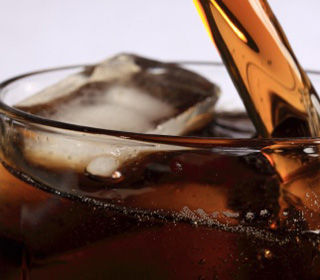
© rodale.comCancer-causing caramel color - the latest reason to give up soda.
If you were to make caramel food coloring at home, you'd melt sugar in a saucepan. Soda manufacturers, however, do things much differently, often creating sugar-ammonia interactions under high pressure and temperatures. The result? An unlabeled cancer-causer in your soda can. At issue is 4-MI, a contaminant found in the cheap artificial "caramel coloring" that makes sodas brown. It's a known chemical carcinogen found at various levels in Coke and Pepsi products.
In government lab-animal experiments, the ingredient has been shown to cause leukemia, as well as lung, liver, and thyroid cancers. Although a safer alternative is available, it's four times more expensive, a price most beverage manufacturers aren't willing to pay.
Labeling laws are stricter in California, so faced with an order to start carrying a cancer warning on its drink cans, Coca-Cola instead reformulated its caramel coloring to ensure it has much lower levels of the contaminant. The rest of the world isn't as lucky, though, according to a new analysis by the Center for Science in the Public Interest (CSPI) that shows dangerous 4-MI levels in sodas sold in states and counties with more lax labeling laws. "Now that we know it's possible to almost totally eliminate this carcinogen from colas, there's no excuse for Coca-Cola and other companies not to do so worldwide, and not just in California," says CSPI executive director Michael F. Jacobson.
Researchers found that Coke samples now sold in California contain 4 micrograms (mcg) of 4-MI, much lower than the 30 mcg that would require a cancer-warning label. However, Coke sold in Brazil contained 267 mcg per 12 ounces; Kenyan samples registered at 177 mcg, while Coke sold in Washington, DC, contained 144 mcg.
The Food and Drug Administration (FDA) says the chemical is still safe, despite CSPI projections that common levels of 4-MI found in Coke and Pepsi cause 15,000 cancers a year. Part of the problem? Chemicals are introduced into the food system before being adequately tested for long-term effects in humans. "It's hard to know how serious a problem food dyes might pose to health because the science is so difficult to do," says Marion Nestle, PhD, professor of nutrition, food studies, and public health at New York University. "If you eat real foods, you don't have to worry about them."
Earlier this year, CSPI's testing detected concerning levels of 4-MI contamination in both diet and regular versions of Coke and Pepsi. "Coke and Pepsi, with the acquiescence of the FDA, are needlessly exposing millions of Americans to a chemical that causes cancer," says Jacobson.
And just as manufacturers add the
flame retardant brominated vegetable oil (BVO) to Mountain Dew, citrus sodas, and certain varieties of Gatorade to keep the ingredients from separating, 4-MI is added to Pepsi and Coke purely for cosmetic purposes, giving the soda its brown color. To help shoppers better understand what's in their drinks, CSPI asked FDA to force manufacturers to disclose when they use ammonia-based caramel colorings, listing "ammonia-sulfite process caramel coloring" or "chemically modified caramel coloring" to the label. So far, nothing has been done as a result of the request.
In addition to Coke and Pepsi, CSPI researchers looked at Whole Foods 365 Cola, Dr. Pepper, and Diet Dr. Pepper. The Pepsi and Coke samples contained 4-MI levels up to five times higher than what would warrant a warning in California. (California's laws on labeling carcinogens are stricter than the law that governs the rest of the country.) Dr. Pepper products tested much lower, but 4-MI levels in those products still pose a cancer risk seven times higher than what the FDA allows for food additives, according to CSPI.
As might be expected, the beverage industry disputed CSPI's findings earlier this year, and in a statement responding to the study, the American Beverage Association said, "this is nothing more than CSPI scare tactics." Nevertheless, shortly after the assessment came out, Coca-Cola announced that it would be switching to a new lower-MI formulation of caramel coloring, in part to avoid cancer labels on its products sold in California. 4-MI appears on the state's stringent Proposition 65 list of chemicals known to cause cancer, and the levels in the CSPI study are high enough that, according to California law, Coke products would have to bear a label along the lines of
"Warning: This product contains a chemical known to the state of California to cause cancer."
Comment: Read more above the evil health effects of soda:
The Real Dangers of Soda to You and Your Children
Do the Chemicals That Turn Soda Brown Also Cause Cancer?
The Facts, Statistics and Dangers of Soda Pop
Soda Ingredients Linked to Cirrhosis and Cancer